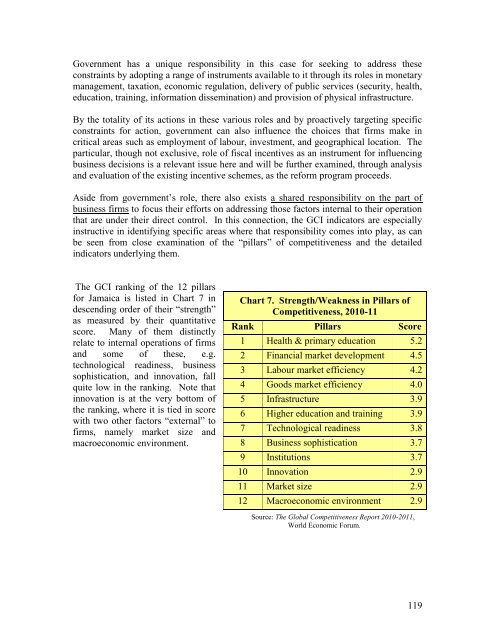PIOJ Growth-Inducement Strategy - Planning Institute of Jamaica
PIOJ Growth-Inducement Strategy - Planning Institute of Jamaica
PIOJ Growth-Inducement Strategy - Planning Institute of Jamaica
Create successful ePaper yourself
Turn your PDF publications into a flip-book with our unique Google optimized e-Paper software.
Government has a unique responsibility in this case for seeking to address these<br />
constraints by adopting a range <strong>of</strong> instruments available to it through its roles in monetary<br />
management, taxation, economic regulation, delivery <strong>of</strong> public services (security, health,<br />
education, training, information dissemination) and provision <strong>of</strong> physical infrastructure.<br />
By the totality <strong>of</strong> its actions in these various roles and by proactively targeting specific<br />
constraints for action, government can also influence the choices that firms make in<br />
critical areas such as employment <strong>of</strong> labour, investment, and geographical location. The<br />
particular, though not exclusive, role <strong>of</strong> fiscal incentives as an instrument for influencing<br />
business decisions is a relevant issue here and will be further examined, through analysis<br />
and evaluation <strong>of</strong> the existing incentive schemes, as the reform program proceeds.<br />
Aside from government’s role, there also exists a shared responsibility on the part <strong>of</strong><br />
business firms to focus their efforts on addressing those factors internal to their operation<br />
that are under their direct control. In this connection, the GCI indicators are especially<br />
instructive in identifying specific areas where that responsibility comes into play, as can<br />
be seen from close examination <strong>of</strong> the “pillars” <strong>of</strong> competitiveness and the detailed<br />
indicators underlying them.<br />
The GCI ranking <strong>of</strong> the 12 pillars<br />
for <strong>Jamaica</strong> is listed in Chart 7 in<br />
descending order <strong>of</strong> their “strength”<br />
as measured by their quantitative<br />
score. Many <strong>of</strong> them distinctly<br />
relate to internal operations <strong>of</strong> firms<br />
and some <strong>of</strong> these, e.g.<br />
technological readiness, business<br />
sophistication, and innovation, fall<br />
quite low in the ranking. Note that<br />
innovation is at the very bottom <strong>of</strong><br />
the ranking, where it is tied in score<br />
with two other factors “external” to<br />
firms, namely market size and<br />
macroeconomic environment.<br />
Chart 7. Strength/Weakness in Pillars <strong>of</strong><br />
Competitiveness, 2010-11<br />
Rank Pillars Score<br />
1 Health & primary education 5.2<br />
2 Financial market development 4.5<br />
3 Labour market efficiency 4.2<br />
4 Goods market efficiency 4.0<br />
5 Infrastructure 3.9<br />
6 Higher education and training 3.9<br />
7 Technological readiness 3.8<br />
8 Business sophistication 3.7<br />
9 Institutions 3.7<br />
10 Innovation 2.9<br />
11 Market size 2.9<br />
12 Macroeconomic environment 2.9<br />
Source: The Global Competitiveness Report 2010-2011,<br />
World Economic Forum.<br />
119
















